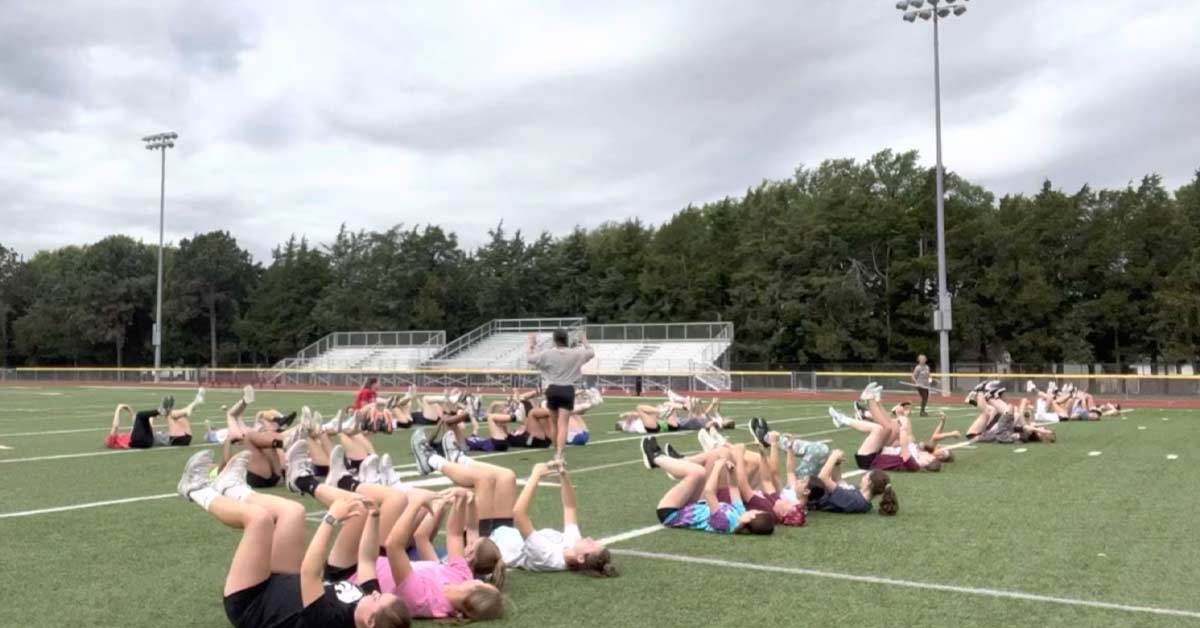Softball athletes spend time year-round practicing skill development in hitting, pitching, throwing, and fielding. Few work on strength and speed, and even fewer address the need to prepare for playing in high heat and humidity. Most outdoor athletes, specifically softball players, face the prospect of playing ball in extreme heat at some point in their seasons—the ability to play 3–4 games in 90+ degree weather with matching percentages of humidity is a skill in itself.
Many athletes underestimate the stress on the body that heat can add and, as a result, suffer from heat-related illnesses or deal with symptoms related to it. Heat stroke is now the leading cause of death in sports.1 Evidence suggests the prevalence of exertional heat stroke among high school athletes is largely due to young athletes not acclimatizing or physically adjusting to the heat, and the heat policies available to prevent this are not always enforced.2
As coaches, we can do our part to help athletes better manage the heat, and we can do this in several ways.
Many athletes underestimate the stress on the body that heat can add and, as a result, suffer from heat-related illnesses or deal with symptoms related to it. We can help them better manage the heat. Share on XOn the strength and conditioning side, especially regarding movement, we spend most of our time trying to help the kids we work with become more efficient. Efficiency equals more strength and endurance for longer periods, less chance of fatigue and injury, and, as a result, increased performance. Part of this efficiency in movement carries over into managing stress—and playing in the heat becomes a game of balancing the stress on the body. If we add a huge stress like heat to the body, we must make sure the body isn’t already overloaded due to other stressors.
Efficiency of Movement
The first thing we address is patterning in quality, fluid, and effective movement in the weight room (see “3 Mistakes Softball Players Make in the Weight Room” for details on this subject). For me, this starts with developing core endurance—the body stays in good alignment and is most efficient when the core is stable and strong. We mix up training the core in different ways throughout a workout to address this need.
Start with Core Endurance
When the body is fresh and strong, we train the core at the beginning of a workout with explosive exercises like:
- Rotational kettlebell swings.
- Med ball slams.
- Med ball throws.
- Banded Pallof marching.
- Plyos and jumps.
We keep reps short with the intent to work fast and violently, under control.
The next time we work core is in the middle of the strength session as a superset to heavier lifts. These movements are sandwiched between variations of squats, bench, and cleans and are most often ISO holds with focused breathing through the nose. Four options we use are:
1. Low-sit plank holds (on elbows and knees).
Video 1. “Ribs stacked over hips” and other cues to execute the low sit plank hold.
2. Deadbug variations with offset weight.
Video 2. Key to the deadbug, not letting the athlete’s back rise up off the ground.
3. Med ball or plate squat distractions (partner game).
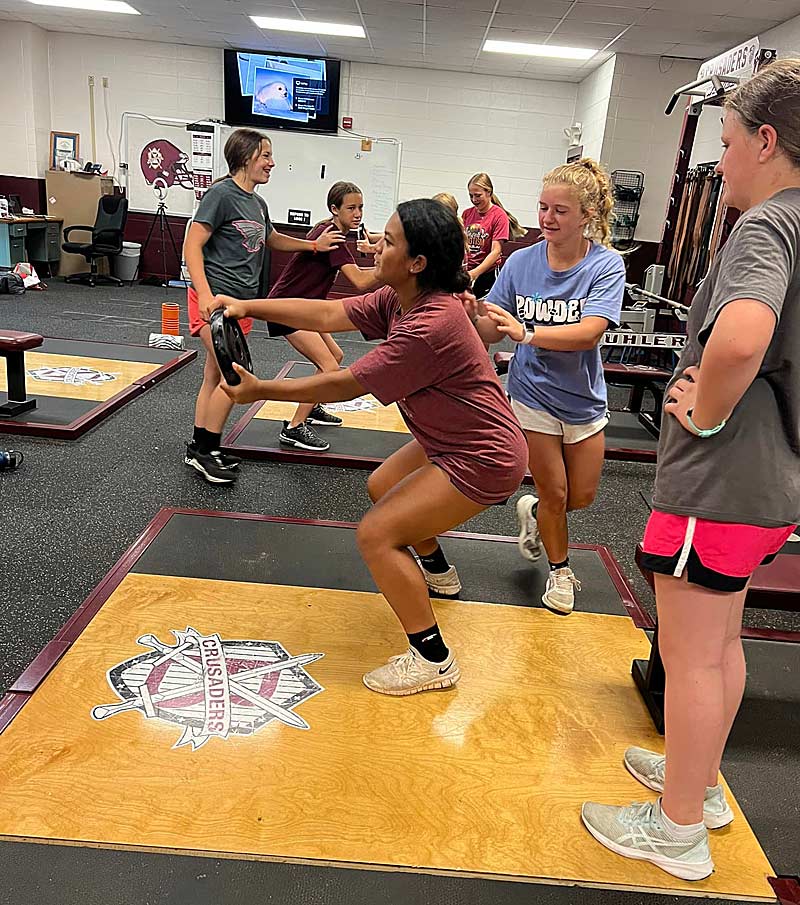
4. Slow crawling.

Then, we end the week with core work at the end of the workout in the form of a long, slow EMOM (every minute on the minute). We include cardio-like movements in the workout as well.
For example, for 10 minutes, every minute on the minute, the athletes complete:
- Five calories on the Air Assault bike.
- Four dumbbell bear rows/arm.
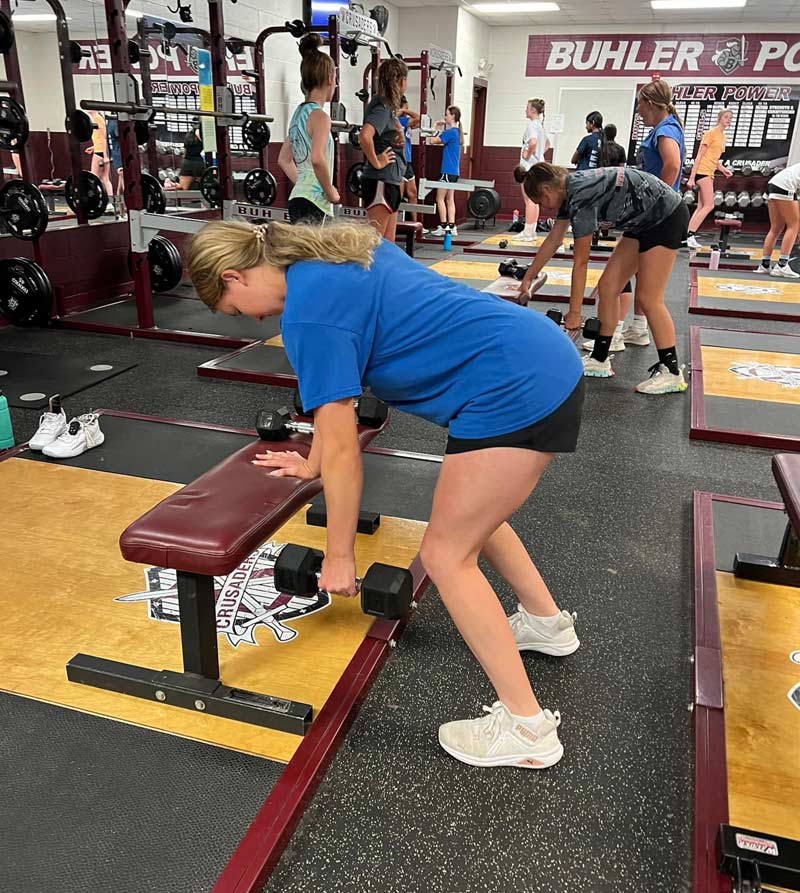
Cardiovascular Endurance
After we’ve addressed core endurance, we next focus on cardio endurance in terms of the cardiovascular system. We focus on training different systems: anaerobic, aerobic, and phosphagen.
I like using games with my softball players to address these areas of training. Again, we do these at the beginning, middle, and end of the workout to challenge the body’s ability to handle stress. Some of our favorites are:
1. Playing Chase or Capture the Flag
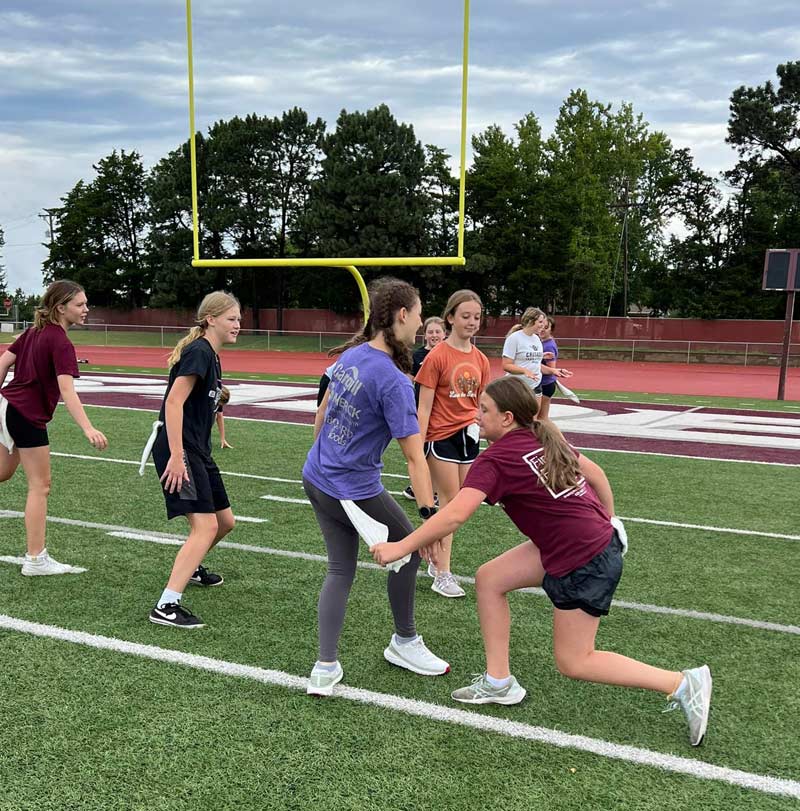
Each athlete places a hand towel in the back of their shorts. The athletes are given a designated space and time frame to collect the most towels. We do this individually or as teams, using different color towels for each team.
2. Med Ball Tag
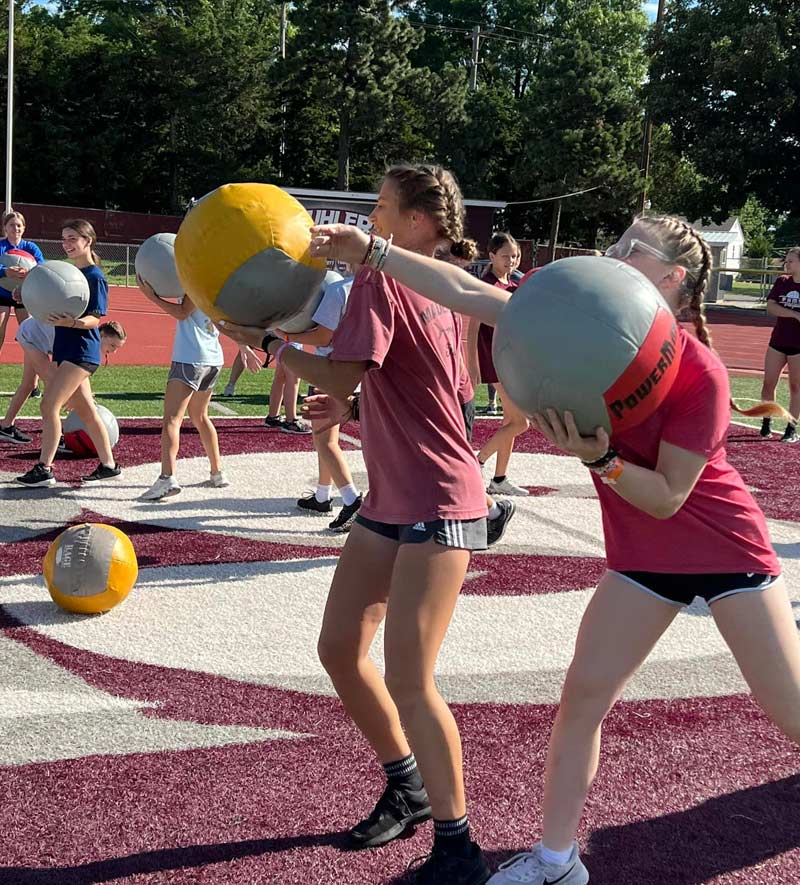
For this game, each athlete is given a med ball, all different sizes and weights. The athletes are given a designated area to stay within. They can vary, but we usually make rules such as the ball can only be held in one hand while the athlete moves and maneuvers themselves within the designated area. The goal is to try and knock other people’s med balls out of their hands. If the athlete’s ball gets knocked out of their hand, they must walk to the outside of the designated space of play and complete 5–10 reps of a specific exercise before re-entering. We vary using push-ups, squats, lunges, jump squats, and sit-ups within the 5- to 8-rep range.
The other rule is that no balls can be lying on the ground throughout the whole game. This quickens the pace of the push-ups and squats or other designated exercise. If a ball is left on the ground, everyone stops and does an exercise.
3. Shoe Drop Game
Video 3. Acceleration and deceleration game based on reacting to visual and auditory cues.
4. COD Bat Game or Stick Game
Video 4. For this game, everyone stands in a circle. Each participant holds their bat at arm’s length in front of their body with the wide end of the bat on the ground and the knob just under their hand. The athletes should stand close, about 1–2 feet apart.
One person not inside the circle is designated as the “caller.” The caller yells out “right” or “left,” and the entire circle should move in the direction called, leaving the bat but moving their hand to the top of the bat next to them with the goal of trying to keep the bats all standing. If the bat a girl is reaching for hits the ground before she reaches it, she is out. The circle stays the same distance apart but has fewer people, making the game more challenging. Or, if the caller wants to add speed to the game, she can cue everyone to take a step back each round, making the bats harder to reach.
Breathing and Mindset
We also spend a lot of time talking about breathing and its important role in quickly reducing the heart rate. We start our workouts with patterning in diaphragmatic breathing through various positions and holds. My favorites are alligator breaths, bird dog positions, and assisted squat holds.
Video 5. Breathing tips for athletes during a squat lift.
I remind my athletes to return their breathing to nose breathing as soon as possible after a cardiovascular effort. Nasal breathing performs the same amount of work with less energy expended. In addition, mouth breathing increases dehydration and, as a result, the chances of heat exhaustion.3 So, the less time we spend mouth-breathing, the better.
I remind my athletes to return their breathing to nose breathing as soon as possible after a cardiovascular effort. Nasal breathing performs the same amount of work with less energy expended. Share on XWe work on this concept by wrapping our fingers around our mid-section to turn intra-abdominal pressure (IAP) breathing back on and lower the heart rate by squatting down or bending over and resting our hands on our knees. We practice these concepts between sets and reps in the weight room or on the field to help build habits that show up in the game.
We also focus on relaxation techniques through end-of-practice activities, such as meditation and visualization. We have the girls line up against the fence or the wall with their legs elevated, one hand on the chest and one on the belly. We tell them to focus on only raising the belly hand to breathe as they work through the body little by little, visualizing the tension and stress melting out of their body and into the floor.
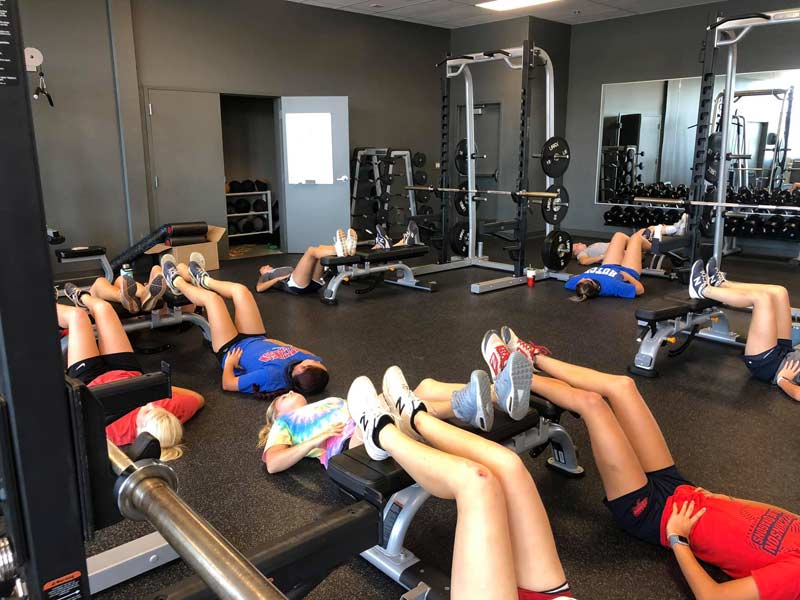
Take Care Off the Field
At the end of the day, though, the biggest pieces for a softball player to manage the stress of high heat in a tournament are what they do off the field:
- Getting enough sleep.
- Drinking enough water.
- Reducing the volume of practice and games leading up to a tournament.
- Eating enough QUALITY calories—not running off energy drinks and Sour Heads.
- Keeping body weight and body fat in normal ranges.
- Reducing sugar and processed food intake.
- Managing emotional stress and trauma with help.
Playing in the heat is a game of checks and balances. If you are going to add a HIGH stressor, like extreme heat and humidity, to the body for long periods, an athlete needs to have removed or diminished another stressor so the body can handle it all.
At the end of the day, the biggest pieces for a softball player to manage the stress of high heat in a tournament are what they do off the field, says @shestrength. Share on XThis is where smart training comes into play in the weight room, in practice, and at home. Much like training for the sport, training for playing in the heat is just as important—but often goes neglected.
Since you’re here…
…we have a small favor to ask. More people are reading SimpliFaster than ever, and each week we bring you compelling content from coaches, sport scientists, and physiotherapists who are devoted to building better athletes. Please take a moment to share the articles on social media, engage the authors with questions and comments below, and link to articles when appropriate if you have a blog or participate on forums of related topics. — SF
References
1. Casa DJ, DeMartini JK, Bergeron MF, et al. “National Athletic Trainers’ Association Position Statement: Exertional Heat Illnesses.” Journal of Athletic Training. 2015;50(9):986–1000. doi: https://doi.org/10.4085/1062-6050-50.9.07
2. Adams WM, Hosokawa Y, Casa DJ, et al. “Roundtable on Preseason Heat Safety in Secondary School Athletics: Heat Acclimatization.” Journal of Athletic Training. 2021;56(4):352–361. https://doi.org/10.4085/1062-6050-596-20
3. Lacomb, COP. “Oral vs. Nasal Breathing during Submaximal Aerobic Exercise.” UNLV Theses, Dissertations, Professional Papers, and Capstones. (2015).

